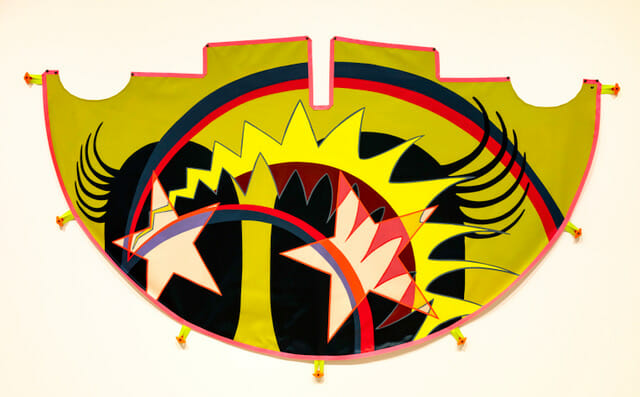Phoenix Art Museum announced the acquisition of Cannupa Hanska Luger’s Incendiary (2023), a vibrantly colored, large-scale tipi work from a recent series that explores the adaptability and versatility of the nomadic structure as a metaphor for the resilience of Indigenous peoples in the face of settler- colonial violence. The painted and shaped canvas is a significant addition to the Museum’s contemporary art collection and furthers the Museum’s efforts to collect and display art that reflects a diversity of voices from the Southwest region and Arizona. Incendiary by Luger was acquired by the Museum with funds from the Men’s Arts Council, a Museum support group dedicated to supporting acquisitions, exhibitions, and education and engagement programming. It is on view now in the Katz Wing for Modern Art.
DEEPER DIVE: Ranking Arizona: Top 10 resorts for 2023
“Adding Incendiary by Cannupa Hanska Luger into the collection of Phoenix Art Museum represents a significant step forward in growing contemporary Indigenous perspectives within the PhxArt Collection,” said Jeremy Mikolajczak, the Museum’s Sybil Harrington Director and CEO. “The work is a wonderful example of how Luger uses Indigenous knowledge to challenge histories and stereotypes and, in dialogue with other works, assertively demonstrates a reframing and repositioning of historical narratives of Native peoples. Incendiary joins other paintings and multimedia works in our contemporary art holdings by contemporary Indigenous artists such as Fritz Scholder and Steven Yazzie.”
Cannupa Hanska Luger was born in 1979 on Standing Rock Reservation in North Dakota. Now based in New Mexico, he is an enrolled member of the Three Affiliated Tribes of the Fort Berthold Reservation and is of Mandan, Hidatsa, Arikara, Lakota, and European heritage. By incorporating wide-ranging media, from ceramics, steel, and fiber to video and repurposed materials, Luger creates monumental installations and sculptures, performances, and wall works that attempt to reframe and reclaim 21st-century narratives about Indigenous cultures and identities. His work unites historical references and tradition with contemporary concerns, all to imagine and dream of Indigenous futures.
Luger is a 2022 Guggenheim Fellow and a recipient of a 2021 United States Artists Fellowship Award for Craft. In 2021, he was named a GRIST Fixer, and in 2020, he was named a Creative Capital Fellow and a Smithsonian Artist Research Fellow, among other previous awards and accolades. Luger has exhibited nationally and internationally at institutions such as The Metropolitan Museum of Art, Gardiner Museum, Kunsthal KAdE, ASU Art Museum, Berkeley Art Museum, New Orleans Museum of Art, Mesa Arts Center, and the National Center for Civil and Human Rights. His work is featured in collections of various museums around the world, including the North American Native Museum (Zürich, Switzerland); the Denver Art Museum; the Museum of Contemporary Native Arts (Santa Fe); the Yale University Art Gallery (New Haven); and the Conley Gallery, California State University (Fresno). Luger holds a BFA in studio arts from the Institute of American Indian Arts.
Incendiary (2023) is one of 10 canvases from Luger’s tipi series, a recent investigation of painting. For the Plains people, tipis represent a nomadic lifestyle, defined by patterns of migration that mirror the movements of buffalo herds. The structures were often made from the skins of hunted buffalo, making them part of the land and the humans who constructed them simultaneously. Tipis also adapt to the land on which they exist, similar to how Indigenous peoples have adapted over centuries of struggle and ongoing conflict with colonizers.
As part of his tipi series, Luger transformed the word “tipi” into an acronym—Transportable Intergenerational Protection Infrastructure. The acronym suggests that the structure can cross time and space, even into future realms of existence, thus solidifying its status as a testament to Indigenous resilience and innovation. Incendiary, like other canvases from the body of work, features recognizable graphic forms of stars and oversized cartoon eyes with curled eyelashes, which are drawn from specific historical references. The eyes reference stereotypical cartoon characterizations of Indigenous peoples in early animations, while the overall pop aesthetic refers to historical air force nose art. This type of nose art first appeared on British Royal Air Force Tomahawks during World War II and was later adopted by U.S. forces to adorn US P-40s, or Warhawks. By appropriating this imagery and placing it onto a Native nomadic structure, Luger reflects on the ability of Indigenous peoples, their knowledge, and their technologies to withstand the colonial violence and aggression these designs represent. It is also a reflection on how Native American cultural motifs have been appropriated by Western popular culture for centuries.




